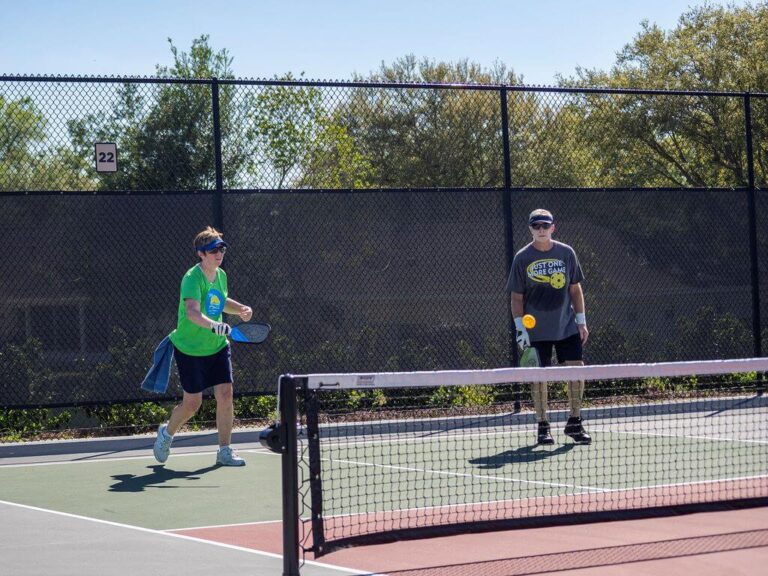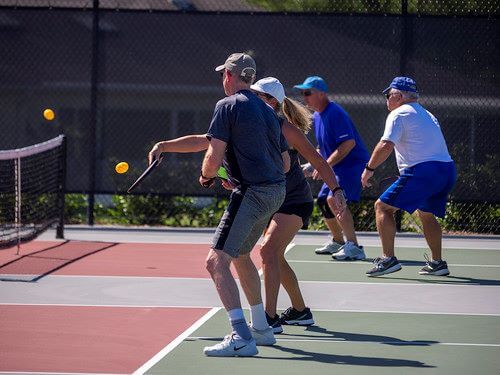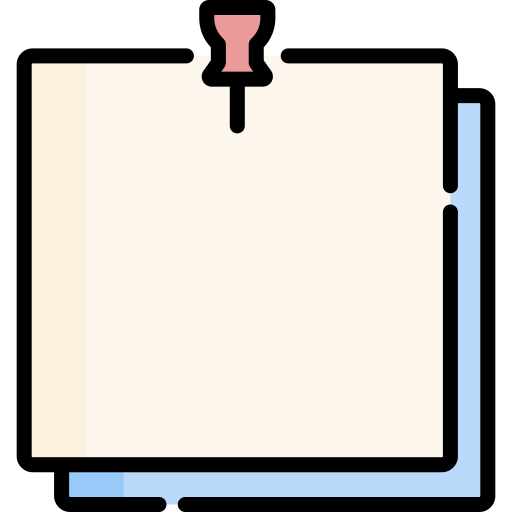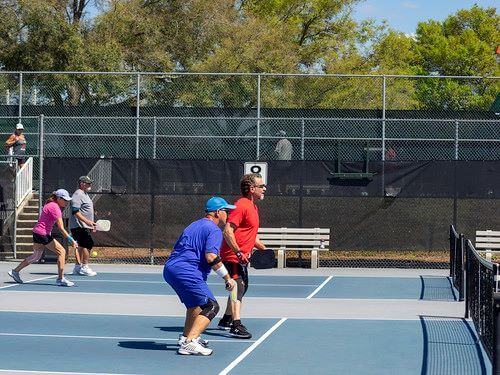Rally scoring in pickleball is starting to become popular, but what exactly is pickleball rally scoring? And how is rally scoring used in pickleball?
While pickleball has drawn tons of inspiration from other court sports, it has always had a few unique elements that make the game interesting and fun. The traditional, standard scoring system of pickleball is different from other well-known racquet sports. But tournaments and players are slowly beginning to adapt rally scoring into their games.
Let’s explore the concept of rally scoring, and what’s good and bad about having it in pickleball.
How Does the Traditional or Standard Scoring in Pickleball Work?
First off, let’s review the traditional, standard scoring system that’s been used in pickleball since the beginning. Side-out scoring is a scoring system where only the serving team can score.
The server starts on the right side of the court if their score is even, and on the left side if their score is odd. The receiver switches sides diagonally according to the alignment of the server. The serving team keeps playing and scoring points until they commit a fault.
This can be either of the following:
- when the server fails to serve the ball above the net
- hitting the ball out of bounds
- stepping into the non-volley zone or kitchen while attempting to volley
When a fault occurs, the serve is handed over to the opponent, and they become the serving team. It now becomes the opposing team’s opportunity to score points while serving.
The players continue to alternate serving and receiving until one side reaches a score of 11 points, winning the game. However, the winning player or team must win by a margin of two points.
What Is Rally Scoring in Pickleball?
Rally scoring in pickleball is a new, very different approach to keeping score in a match. It has gained attention and sparked discussions within the pickleball community in recent years.
A point is awarded on every single rally, regardless of whether it’s the serving team or the receiving team that wins the rally. This gives both teams an equal opportunity to score points during each rally, making every shot and every rally in the game crucial. This adds an extra layer of excitement and competitiveness to the game.
What Is a Rally in Pickleball?
In pickleball, a rally refers to the continuous exchange of shots between players that takes place after the ball is served and before a fault or rule violation occurs. During a rally, players take turns hitting the pickleball ball over the net. The aim is to land it in such a way that it’s difficult for your opponent to counter.
The rally continues until a fault or violation occurs.
Does Pickleball Need to Switch to A Rally Scoring System?
The adoption of rally scoring in pickleball has sparked debates among players and enthusiasts. Those who are for the change argue that it will leads to faster and more exciting games, improved accuracy of player ratings, and also makes the sport more accessible for beginners.
On the other hand, there are concerns that rally scoring alters the balance between the serving and receiving teams, potentially leading to unfair outcomes. Some have also argued that changing the scoring system may confuse players who are accustomed to the traditional side-out scoring.
In short, there are a lot of reasons why rally scoring is a great system and why it should work for pickleball. Unfortunately, it’s not all black and white. We’ll discuss all of this below, under the pros and cons of using rally scoring for pickleball.
Pros and Cons of Using Rally Scoring in Pickleball
While the traditional side-out scoring system in pickleball has been the norm since the sport’s inception, it may not be so bad to adapt a different scoring system. Pickleball rally scoring has both advantages and concerns.
In this next section, we will explore how pickleball rally scoring can make the game faster and more exciting but also consider concerns about how it might affect the balance between the serving and receiving teams.
Benefits of Using Rally Scoring in Pickleball
Rally scoring offers a myriad of benefits that not only make pickleball more enjoyable but also significantly more streamlined and fair. Here are the key advantages of adopting rally scoring in pickleball.
| Advantages | |
|---|---|
| Beginner-Friendly: | Rally scoring is beginner-friendly. It simplifies the game, making it easier for newcomers to grasp the rules and enjoy the game without being overwhelmed by the intricacies of the traditional scoring system. |
| Predictable Game Times: | Since points are scored on every serve, games will have a more consistent duration. This is particularly beneficial for players who want to manage their time more effectively, or for venues that need to schedule multiple matches.
In the context of tournaments, rally scoring accelerates the pace of play and prevents unnecessary delays. |
| Fairness of the Game: | Since each rally carries the potential for scoring, both players or teams have an equal opportunity to score points, removing any perceived advantage that might come from serving first. This could further reduce the need for the two-bounce rule in pickleball and open up the field for faster, more dangerous services. |
| Accurate Player Statistics: | The traditional scoring system only awards points for the serving team. So, all the rallies “won” by the receiving team aren’t counted and aren’t worth any points.
A rally scoring system where every rally generates a point will actually be more accurate for player statistics. It’s similar to how basketball players have a statistic of the number of points scored throughout their whole career. |
| Encourages Comebacks: | Because every rally can lead to a point, a player or team trailing in the score has more opportunities to catch up and potentially overtake their opponents. This ensures an exciting game for players and spectators until the very end. |
Drawbacks of Rally Scoring in Pickleball
Despite the numerous advantages, rally scoring in pickleball can lead to shorter game times, reduced strategic depth, community divide, and might represent an unnecessary change. It’s crucial to consider these factors when deciding on the best scoring system for your particular pickleball context.
| Drawbacks | |
|---|---|
| Shorter Game Times: | It makes game times more predictable, but it also leads to shorter matches. This can be a downside for players who prefer more drawn-out games where they can fully immerse in the strategic aspects of pickleball. |
| Reduced Strategy: | Traditional scoring requires players to only defend during the opponent’s serve, which adds a layer of strategy to the game.
But rally scoring does the opposite and may instead lead to a reduction in strategic depth. With points at stake at every rally, the strategic element of ‘serve-defense’ can be diminished. |
How to Do Rally Scoring in Pickleball
With all of that in mind, it’s time to talk about how to do rally scoring in pickleball.
A game of pickleball using rally scoring begins at 0-0, with one team serving from the EVEN side of the court. Here are the basics of how to implement rally scoring in pickleball:
- Each rally in a game is worth a point.
- Forget server one and server two. Each side will have only one person serve until that team loses a rally (point), and then it’s the other team’s turn to serve (side out).
- The right side of the court is the EVEN side, and the left side is the ODD side.
- When a team’s score is even, service is made from the even side of the court. When a team’s score is odd, the service is made from the odd side of the court?.
Let’s illustrate the rules through this example. We’ll call the serving team “Team A”, and the receiving team “Team B”.
If Team A wins a point during their serve, their score becomes 1-0. The players then move to the odd sides since Team A’s score is now an odd number. And since Team A won that rally, they get to serve again. If they also win the second rally, resulting in a 2-0 score, they revert back to the even sides of the court. Then Team A serves again.
If Team B wins the next rally, they earn a score of 2-1 and become the serving team for the next rally. Since Team B has a score of 1 (an odd number), the server stands on the odd side of the court. This process continues until the game ends.
Some additional points to keep in mind:
- Players do not switch to the alternate service court unless they are the serving team, and they have won a point.
- The serving team’s score determines the side from which the ball is served.
- Since the game is completed faster, the ending score may be extended to 15 or 21.
- Decide beforehand if it’s a win by 15 or 2?1?.
Pro Tips on How to Use Rally Scoring to Win Games
The traditional scoring system of pickleball is advantageous for the serving side. After all, the receiving teams cannot score and can only block or defend.
In rally scoring, where every rally is an opportunity to score, receiving teams can take advantage of lenient servers.
One strategy players can adopt is to maintain consistent pressure on their opponents since any lapse could result in a point loss, even when they’re serving. Service should be utilized more strategically as the risk of losing points is higher.
Frequently Asked Questions About Rally Scoring in Pickleball
Q: Is Rally Scoring Used in All Pickleball Tournaments?
A: While more tournaments are adopting rally scoring, not all of them use it. It’s always important to check the rules first before participating in a tournament.
Q: What Are the Common Misconceptions About Rally Scoring?
A: Some players believe that rally scoring eliminates the advantage of serving. This is untrue because having the serve still allows you to control the first shot and potentially set the tone.



































